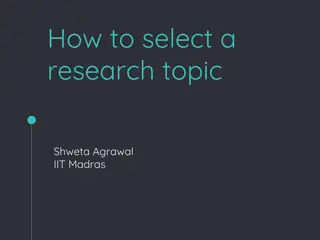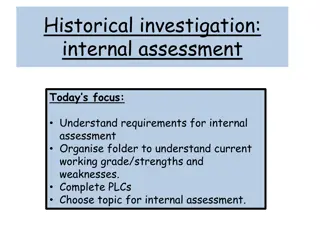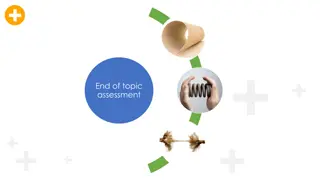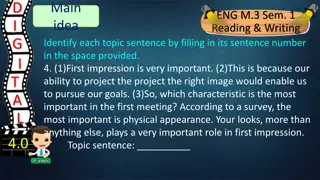
Introducing Object-Oriented Programming in Python
Learn the basics of Object-Oriented Programming (OOP) in Python, including its concepts, data hiding, classes, instances, methods, and the advantages of organizing software with OOP. Explore examples and understand why OOP is essential for software development.
Uploaded on | 3 Views
Download Presentation

Please find below an Image/Link to download the presentation.
The content on the website is provided AS IS for your information and personal use only. It may not be sold, licensed, or shared on other websites without obtaining consent from the author. If you encounter any issues during the download, it is possible that the publisher has removed the file from their server.
You are allowed to download the files provided on this website for personal or commercial use, subject to the condition that they are used lawfully. All files are the property of their respective owners.
The content on the website is provided AS IS for your information and personal use only. It may not be sold, licensed, or shared on other websites without obtaining consent from the author.
E N D
Presentation Transcript
TeachingLondon Computing A Level Computer Science Topic 6: Introducing OOP William Marsh School of Electronic Engineering and Computer Science Queen Mary University of London
Aims What and why OOP? The problem of software development OOP concepts Data hiding Class and instances Using classes in Python Using classes example of files Methods versus functions Create a new class in Python
What is OOP? Object-oriented programming IS An idea for organising programs Object-oriented programming IS NOT A completely different type of programming Builds on if, while, functions etc Necessary: remember it s all assembly code eventually At first, OOP is more complex
Why Organise S/W? Hard to organise large problem Work must be shared across a team Imagine building a house with no plan? Advantages claimed for OOP organisation Better reuse of code in libraries Software easier to change OOP very popular for Graphical User Interface (GUI) libraries
Software Organisation So Far Break overall program into functions Function def Function def Discussion: is it obvious what functions to choose? Function def Main program Initialise variable Call functions Aside: more complex organisation possible
Exercise 1.1 (and 1.2) Use google to find an example of a failed software project in the UK How late? How much money wasted?
Data Hiding Abstraction Different ways to represent complex data Example: shopping list List of pairs: (item string, amount integer) Dictionary: map from item to amount required Data hiding principle: the user should not know the representation It may change Instead, provide functions (or operations )
What's a CLASS I A box with buttons (functions or operations or methods) Parameters in class def f1 Return value def f2 A class is just a template
Words Method: this word is used in OOP theory Function: Python has these, as do other programming languages Operation: this word is used on OO analysis
What's a CLASS II A box containing data (variables) Parameters in class def f1 Return value data def f2 A class is just a template
Picture of Classes Data hiding: Hide the attributes Use the operations A class has A name Attributes (i.e. variables) Operations (i.e. functions) Friend name phone number setNumber sendText Class name Attributes Operations
Object: An Instance of a Class A class is a template An object is a particular instance of a class Different data (attribute values) Same code alice: Friend name = "Alice" phone number = 123 bob: Friend name = "Bob" phone number = 456
Exercise 2.1 Shopping Functions Recall the shopping list representations: List of pairs: (item string, amount integer) Dictionary: map from item to amount required Suggest the functions that would be useful What do you do with a shopping list?
Using Objects in Python You already do this
Example: Files file object import io function or method f = open("hello.txt", 'w') f.write("This is a line\n") f.close() method There is not a file class; the object is of one of several classes
Example: Two Files f and g are different objects import io f = open("hello.txt", 'w') g = open("bye.txt", 'w') f.write("Hello to you\n") g.write("Good bye. Go away.\n") f.write("You are welcome\n") g.close() f.close()
What Data is in the File Object? We are not told: details probably depend on the OS File name Location of file on disk Buffer of text Each file object must have different data
Function and Method Syntax object strng1 = "hello william" n = len(string1) dot function name strng2 = strng1.upper() class name str is a class str(99) returns a string object Equivalent syntax function name str.upper(strng1)
Functions and Methods strng1 = "hello william" n = len(string1) object function name strng2 = strng1.upper() The strng1 object has a class Take the upper() function from this class Call it with the object as the first parameter add any further parameters
Lists are Objects >>> lst = [1,2,3,4] >>> lst.append(99) >>> lst [1, 2, 3, 4, 99] >>> lst = [1,2,3,4] >>> type(lst) <class 'list'> >>> list.append(lst, 99) >>> lst [1, 2, 3, 4, 99] The list is changed Append 99 to the list lst Nothing is returned
Exercise 3.1 and 3.2 Look at String and List method in the Python documentation Try some out.
Define New Classes in Python This bit is new
Declaring A Class A person class with two functions class Person: def setAge(self, a): self.age = a def getAge(self): return self.age setAge() function sets an attribute age Remember: in Python variables are initialised, not declared
Using The Person Class Create instance of the Person class i.e. people! Use class name to construct new objects p1 = Person() p2 = Person() p1.setAge(21) print(p1.getAge()) p2.setAge(101) print(p2.getAge())
What is self? The name self is used by convention Not a key word Always use it Explanation (not essential) In the dot syntax, object is first parameter so function called with method syntax needs at least one parameter
Exercise 4.1 Person Class Enter the Person class The class declaration and the using code go in the same file Add another attribute: What else can you know about a person?
Problem Initialising Attributes What happens if we get the age before it is set? p1 = Person() p2 = Person() print(p1.getAge()) p1.setAge(21) Need to initialise the attributes
Constructor Constructor is a special function Called using class name class Person: def __init__(self, n): self.name = n self.age = 0 def setAge(self, a): self.age = a def getAge(self): return self.age
Using a Constructor Constructor called using class name p1 = Person("Alice") p2 = Person("Bob") print(p1.getAge()) p1.setAge(21) If you do not define a __init__ the default constructor creates an empty object
Exercise 4.2 Add a Person Constructor Add a constructor to the person class Initialise all the attributes Either to default values Or to values given as parameters Write code to use the class
Working With Many Source Files Module file containing Python definitions Contains function and class definitions Guideline Write each class in a separate file Filename same as class name Import: from Person import Person
Summary Object-oriented programming is a way to organise more complex programs Learn the syntax and behaviour Learn how to use OO to organise a program A class is a template for an object. An object has Attributes: what is unique about this object? Operation: what can you do to it? Data and code are organised together Supports data (information) hiding abstraction






















